When prices rise faster than salaries, traditional budgeting stops working. The cost of food, fuel, housing, and daily essentials doesn’t just “increase” — it jumps unpredictably, and your old spending habits can become financially dangerous overnight.
This guide is designed to help you stay financially stable even when the economic environment becomes uncertain, unstable, or hyperinflationary.
🎯 Why You Must Take Hyperinflation Seriously
Hyperinflation does not start as a dramatic event. It begins slowly:
| Stage | What Happens | Risk to You |
|---|---|---|
| Mild Inflation | Prices rise 3–10% annually | Minor savings loss |
| High Inflation | Prices rise 10–40% annually | Savings lose value rapidly |
| Hyperinflation | Prices rise 50% per month or more | Salary becomes nearly worthless |
The moment you notice your monthly budget isn’t stretching the same — it’s already affecting you.
Your job is not just to earn money — it is to protect its value.
🔥 Core Principle: Money Loses Value, But Skills and Assets Do Not
Instead of only focusing on how to spend your income,
start focusing on how to preserve buying power.
This requires:
-
A new budgeting system
-
Smarter income decisions
-
Strategic purchasing behavior
Let’s break it down.
1. Adopt a Dynamic Budget — Not a Static One
Most people use a fixed monthly budget, but during rising inflation, prices do not stay fixed.
✅ Switch to a Weekly Rolling Budget
| Category | Old Method | Hyperinflation-Proof Method |
|---|---|---|
| Budgeting Period | Monthly | Weekly |
| Price Adjustments | Rarely | Constantly |
| Cash Flow Accuracy | Low | High |
| Reaction to Price Change | Slow | Immediate |
Why weekly?
You can adjust faster, prevent overspending, and track price spikes before they become unmanageable.

2. Prioritize Spending Using the “Survival-first” Hierarchy
Before money is allocated elsewhere, it must secure your essentials:
| Priority Level | Category | Why It Matters |
|---|---|---|
| 1️⃣ | Food, Water, Medicine | These are life-sustaining and become expensive fastest |
| 2️⃣ | Housing & Utilities | Stability prevents bigger future costs |
| 3️⃣ | Work-Related Expenses | Allows income to continue |
| 4️⃣ | Savings & Investment | Protects future purchasing power |
| 5️⃣ | Lifestyle & Optional Spending | Cut here first |
If your income drops, only level 5 should feel it — not levels 1–3.
3. Convert Disposable Income into Tangible Value
Cash loses value during hyperinflation.
So convert it into usable value as soon as possible.
Examples of “Value-Stable” Purchases
-
Shelf-stable foods 🍚
-
Necessary home items 🧴
-
Work tools you rely on 🔧
-
Reusable products vs. single-use
These items save future money, because you avoid paying higher later prices.
4. Create Multiple Income Streams (Even Small Ones)
A single salary is vulnerable.
In rising cost environments:
-
Skill-based income rises fastest
-
Time-based income (salary) falls behind the cost of living
Start with small, realistic additions:
-
Freelance support in what you already know
-
Local tutoring, training, or repair service
-
Digital services (editing, design, writing, consulting)
-
Selling unused, stored, or homemade items
Even an extra 10% income can neutralize inflation if added consistently.
5. Store and Preserve Value — Do Not Hoard Cash
When inflation jumps, cash loses value daily.
What retains value better than cash?
| Type | Examples | Why It Helps |
|---|---|---|
| Consumable Assets | Rice, oil, medical supplies | Will always have demand |
| Skill Assets | Courses, certifications | Cannot lose purchasing power once learned |
| Income Tools | Laptop, toolkit | Enables earning, not just saving |
This is not “prepper thinking” — it is economic survival strategy.
6. Track Unit Prices — Not Total Cost
Instead of saying:
“I spent $100 on groceries”
Track:
“Price per kg / liter / unit”
This helps you:
-
Identify cheaper alternatives fast
-
Detect price increases early
-
Buy efficiently before the next cost jump
7. Negotiate Hard — This Is Expected in High-Inflation Markets
Businesses adjust prices aggressively — you should negotiate aggressively too.
-
Ask for discounts
-
Request better payment terms
-
Buy in bulk with friends or family
-
Switch brands without emotional bias
In hyperinflation, loyalty to a brand costs money, not convenience.
📌 Practical Action Checklist (Print or Save This)
| Task | Frequency | Purpose |
|---|---|---|
| Review essential prices | Weekly | Detect inflation early |
| Reallocate budget based on new prices | Weekly | Keep financial balance |
| Stock long-lasting essentials | Monthly | Lock in lower prices |
| Learn or practice an income skill | Weekly | Increase earning ability |
| Reduce optional spending | Daily | Preserve value |
💡 Final Thought
Hyperinflation doesn’t destroy everyone — it rewards people who adapt early.
If you:
-
Track your spending closely
-
Adjust your budget frequently
-
Convert money into lasting value
-
Grow multiple earning sources
You won’t just survive rising costs — you will stay in control.





